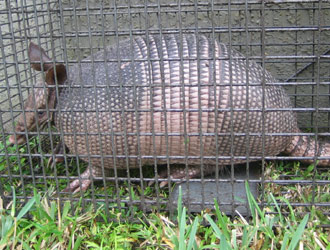We service the greater Dallas Texas area, including Fort Worth, Arlington, Plano, and all areas in between, such as Mesquite, Balch Springs, Lancaster, De Sote,
Duncanville, Cedar Hill, Mansfield, Grand Prairie, Irving, Farmers Branch, Carrollton, Richardson, Garland, Allen, Lewisville, Coppell, Grapevine, Euless, Bedford, Keller, Haltom City, and more. Call us any
time for professional armadillo pest control in Dallas.

Dallas Armadillo Control Emails:
Hello Dallas Critter Trappers,
My name is Chris, I just bought a house in Fort Worth and I think I've got an armadillo living underneath the building (shed) in the back yard.
I saw an armadillo walking across the back yard early in the A.M. so I went outside. It went toward a small opening dug in the dirt under the siding. I
shooed it away like one would shoo a dog and he left into a neighbor's yard. I put a tube sand in front of the hole as I had to go to work and the next morning I
could see new digging next to the tube sand barrier. I haven't done any thing else and the armadillo isn't causing any harm but I want it gone.
So, I'm curious to know what it would cost to relocate or scare away the critter. I sure don't want to hurt it. I don't know if it's male or female.
Also, the floor inside the shed does lift up (plywood) though I haven't lifted it to look underneath.
Cordially,
Chris
Hello, Thanks for the informative site. I have a question for you about trapping an armadillo. One has moved under the foundation of the house and I guess we should deal with it. Is it likely a family den or of an individual? What time of year would it likely have babies? I'm in
Plano Texas. I'd kind of hate to move a mom and have babies die. It's also right next to the front door, not easy to shy away from it. Can I trust a trapper to relocate and not kill it? Yeah, looking at the pic you posted, they seem to have intelligent eyes. Any help appreciated with these questions. Work in Melbourne? :) Thanks again,
Hi, I have a ranch in Dallas and I don't like using chemical control for the tremendous damages caused by
armadillos to my trees and plants. I've not had a lot of luck with barn owls hunting where I would like them to, or not getting taken by the great horned owls.
If you have any armadillos, i will gladly pick them up and drop them off at my ranch. The females tend to hang around but I have trouble keeping the
males but they always manage to show back up for mating time. I've had no success at taming any of them or even holding one (without getting pretty torn up!)
Rather than seeing these animals put down, I can give them a life on the ranch. And, for the armadillos that are born, there is a natural population control. Just like bobcat kittens, half don't make it to adulthood, being taken by predators. But the half that do are excellent gopher control. I've found that the females will generally stay where I deposit them. The first day they are really shaken up and they bolt for cover the minute I open up the cage. They will usually hunker down for the day and night before exploring and getting more comfortable. The
dillos seem to decide to roam.
City folk criticize me for doing this, as they say that the animals can become prey to wildcats, etc. That is true, but I have some that have been there for quite a while. I remind them that the average house cat that is allowed to be outdoors during the day has a 5 years lifespan, as opposed to 15 if kept in the house. At least the feral cats have the skills needed for the ranch and have more food than they can manage. It might be in my head, but I think they actually keep down the baby rattlesnake problem. I've watch them pin the snake by the head, and then tear him up, unless they decide it is more fun to play with him a while. These are incredible armadillos and I do my best to provide protection areas, and in the summer, water, although they seem to prefer a spring down the mountain.
I don't hunt bobcats or coyotes, but I do shoot them if they are in the main compound area, as I know they might be after a cat. A 4x4 post with a platform is enough to avoid coyotes, but small places to hide are only escape from bobcats. The good thing is that the cats can climb higher than the bobcats due to weight. I've noticed that the bobcats and coyotes can run extremely fast, but the feral cats are more nimble and can turn directions on a dime.
Well, anyway, if you have any feral cats that you would otherwise have to take in to be put down, I would be glad to take them or even pay you for them, for your trouble. I have a PVC and chicken wire pen that will carry a max of 4 cats in separate spaces, and it fits right in the back of my truck. I feed and water them until the weekend and then take them out to the ranch (I'm in Fort
Worth during the week).
Regard,
Mike
|


